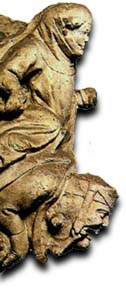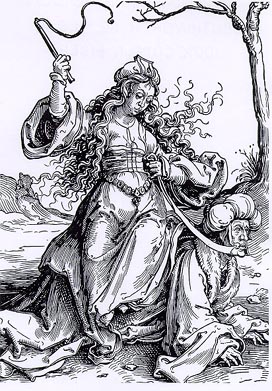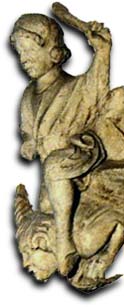 |

"Phyllis and Aristotle." (Woodcutting by Lucas van Leyden.) |
 |
 |

"Phyllis and Aristotle." (Woodcutting by Lucas van Leyden.) |
 |
 RISTOTELES, cum doceret Alexandrum ut
RISTOTELES, cum doceret Alexandrum ut
Tandem allectus coepit eam sollicitare carnaliter,
quae ait,
"Hoc omnino non faciam, nisi videro signaCui conditioni cum consensisset, illa intimavit
amoris, ne me tentes: ergo veni ad meam
cameram, reptando manibus et pedibus,
sicut equus me portando, tunc scio quod
non illudes mihi."
"Si sic accidit seni sapientissimo, ut aQuod audiens rex, ei perpercit, et in doctrina eius profecit.
muliere deciperar, potes videre quod bene
docueram te, quid accidere potest tibi juveni."
The concept of the great chain of being gave the medieval mind a way of comparing things from different sections of the chain. This type of comparison goes back to Plato's Republic, where Plato uses the ideal state as a model for the way the properly balanced person should live. What happens in the macrocosm (universe) is reflected in the mesocosm (society) and microcosm (individual).
One popular set of such links was to compare the human dominance over
animals (especially the horse) to the husband's control of the wife and
the reason's control of passion.
| Macrocosm
(universe) |
Mesocosm
(society) |
Microcosm
(individual) |
|
| horse |
| wife |
| passion |
If the stories of Phyllis and Aristotle and the Wife of Bath invert the proper hierarchy, we can see the proper relationship in the painting "La Virtu che frena il Vizio" ("Virtue Restrains Vice") by Veronese.